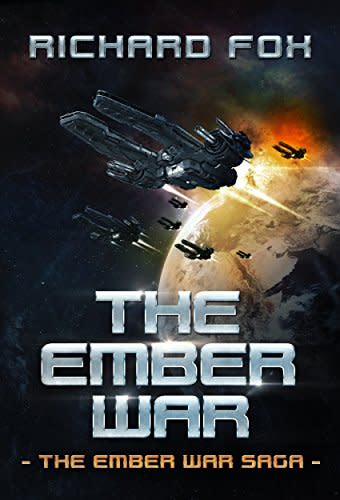 “This message is for my fleet. What I have to say is hard to accept, but you must listen.” Ibarra looked up at the camera. “As of now, you are all that is left. Every human being on Earth, the moon, Mars, everywhere…is dead.”
“This message is for my fleet. What I have to say is hard to accept, but you must listen.” Ibarra looked up at the camera. “As of now, you are all that is left. Every human being on Earth, the moon, Mars, everywhere…is dead.”
An alien probe lands south of Phoenix, Arizona in the Gila River Indian Reservation with a warning for Marc Ibarra, a promising young college student attending Arizona State. Sixty years later, after ushering in a revolution that led humanity into space, Ibarra watches over a colonization fleet aimed for the outer planets.
He lied.
Moments after the Chinese attack the fleet, the drives “malfunction”, sending the colonists and their military escorts 30 years into the future–30 years after the alien Xaros erased humanity from the solar system. For the sole ember of humanity to survive, it must drive the remaining Xaros from the system–something countless extinct alien species have failed to do.
Like many of its contemporaries, Richard Fox’s The Ember War is a genre-blender, combining mecha combat with classic military science fiction battles. The centerpiece for humanity’s survival is the enigmatic and secretive armor, a humaniform mech that serves as infantry, artillery, and, well, armor. piloted by specially trained soldiers who serve as the mech’s nervous system. Unlike most mecha stories, The Ember War follows the infantry as main characters. The arrival of armor in a battle is not just a fearsome force multiplier, it is the unleashing of brutal destruction on the battlefield. Unlike most mecha tales, Fox knows combined arms, so while armor dominates the battlefield, it does not dominate the action.
The keen-eyed will find more than a few homages to the classic mecha show Macross. Humanity’s survival depends on a fleet lost when FTL drives “malfunction” and defended by somewhat variable shaped mechs. And much of the action takes place in a post-apocalyptic wasteland–or Phoenix in the summer. Fortunately, there is no sign of a Minmei or any other idol singer, and the homages are far more subtle than the American Macross, Doc Travis Taylor’s Tau Ceti Agenda. Still, the familiar beats help bridge the barriers caused by a new and unfamiliar universe.
However, the unique universe of The Ember War has been give plenty of room to unfold. As the first book in the nine-volume series, The Ember War serves as the introduction to a larger framework of stories, including the Terran Armor Corps. Featuring the Dragon Award-winning Iron Dragons, the Terran Armor Corps series adds Heinleinesque and Ringoesque explorations of why soldiers fight without the excesses Heinlein and Ringo are known for. Iron Dragoons joins Cartwright’s Cavaliers and A. I. Destroyer as recent classics exploring the soldier’s life, masculinity, and growing into responsibility. That future rests on the solid foundation of The Ember War.
As an aside, The Ember War is part of the growing body of science fiction written by Rocky Mountain authors. With the rise of popularity of Orson Scott Card and Kevin J. Anderson, a vibrant science fiction and fantasy scene has sprung up in the mountainous West, one prone to using the mountains and the Southwest as a setting. Phoenix has become an increasingly popular setting for such authors, reflecting its growing importance in music and culture. And, as one who could once look out the window and see where The Ember War takes place, Fox nails South Phoenix, placing the action in an area with unique ties to space and defense.
In short, the Ember War is a thrilling mecha mil-sf series that you can give without reservation to younger readers. And as the series develops, you have a chance to watch Fox come into his own as a writer. Highly recommended.
As of the time of writing, there are three days left in The Ember War Graphic Novel crowdfunding campaign. The creative team of Flying Sparks (Jon Del Arroz, Jethro Morales) is bringing Richard Fox’s bestselling series to life with 120 PAGES (150 with stretch goals!) of action-packed comic.
Please give us your valuable comment